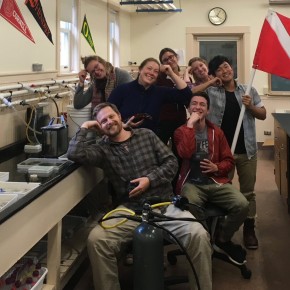Aaron Galloway and the members of the Coastal Trophic Ecology Lab (CTELab) generally examine trophic interactions in food webs through field studies and by analyzing lipid and isotopic biomarkers that specify sources of food. When biomarker methods are calibrated with controlled feeding trials, isotopic and lipid signatures in macroalgae and phytoplankton can be traced into grazers, indicating food source, and trophic position (Brett et al. 2016). Essential fatty acids are synthesized by plants and algae and are key drivers of ecosystem production due to their importance for the nutritional physiology of fish and invertebrates (Dalsgaard et al. 2003).
There are several possible projects on 3 different crustaceans for REU students in the summer of 2017: (1) Isopods: characterize feeding preferences, behavior, and growth rates of marine isopods fed pure and mixed macroalgal diets (Galloway et al. 2014); these questions could be asked in laboratory feeding trials and further informed by some field-based observations. (2) Copepods: evaluate growth, behavior, and reproductive success of intertidal tide-pool copepods feeding on urchin feces from urchins fed different algae; this project would take place in the lab, using “copepod condos”, and could also include training in the methods for fatty acid extraction and analysis. (3) Crabs: evaluate size, growth, and feeding behavior of newly settled Dungeness crab recruits (Galloway et al. 2017); this project would use a combination of lab experiments and analysis of photos/video taken by divers. Unless the student already has an active AAUS certification, it is not likely that the REU students will be able to participate in dives.
Brett, M. T., M. E. Eisenlord, and A. W. E. Galloway. 2016. Using multiple tracers and directly accounting for trophic modification improves dietary mixing-model performance. Ecosphere 7:e01440.
Dalsgaard, J., M. St. John, G. Kattner, D. C. Müller-Navarra, and W. Hagen. 2003. Fatty acid trophic markers in the pelagic marine environment. Advances in Marine Biology 46:225–340.
Galloway, A. W. E., M. E. Eisenlord, M. N. Dethier, G. Holtgrieve, and M. T. Brett. 2014. Quantitative estimates of isopod resource utilization using a Bayesian fatty acid mixing model. Marine Ecology Progress Series 507:219–232.
Galloway, A. W. E., A. L. Shanks, S. Groth, S. R. Marion, and A. R. Thurber. 2017. Massive crab recruitment events to the shallow subtidal. Ecology doi: 10.1002/ecy.1740
.

